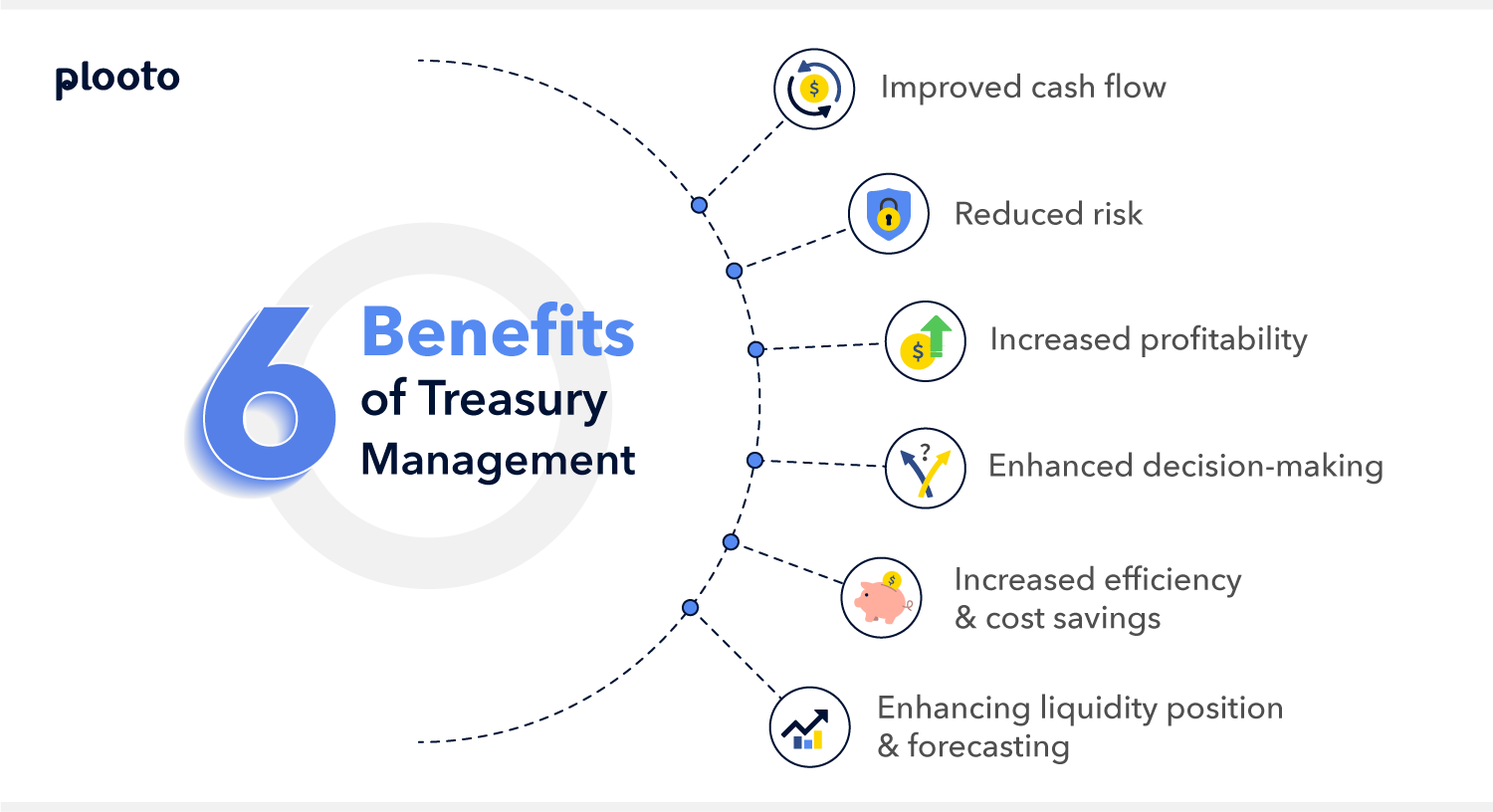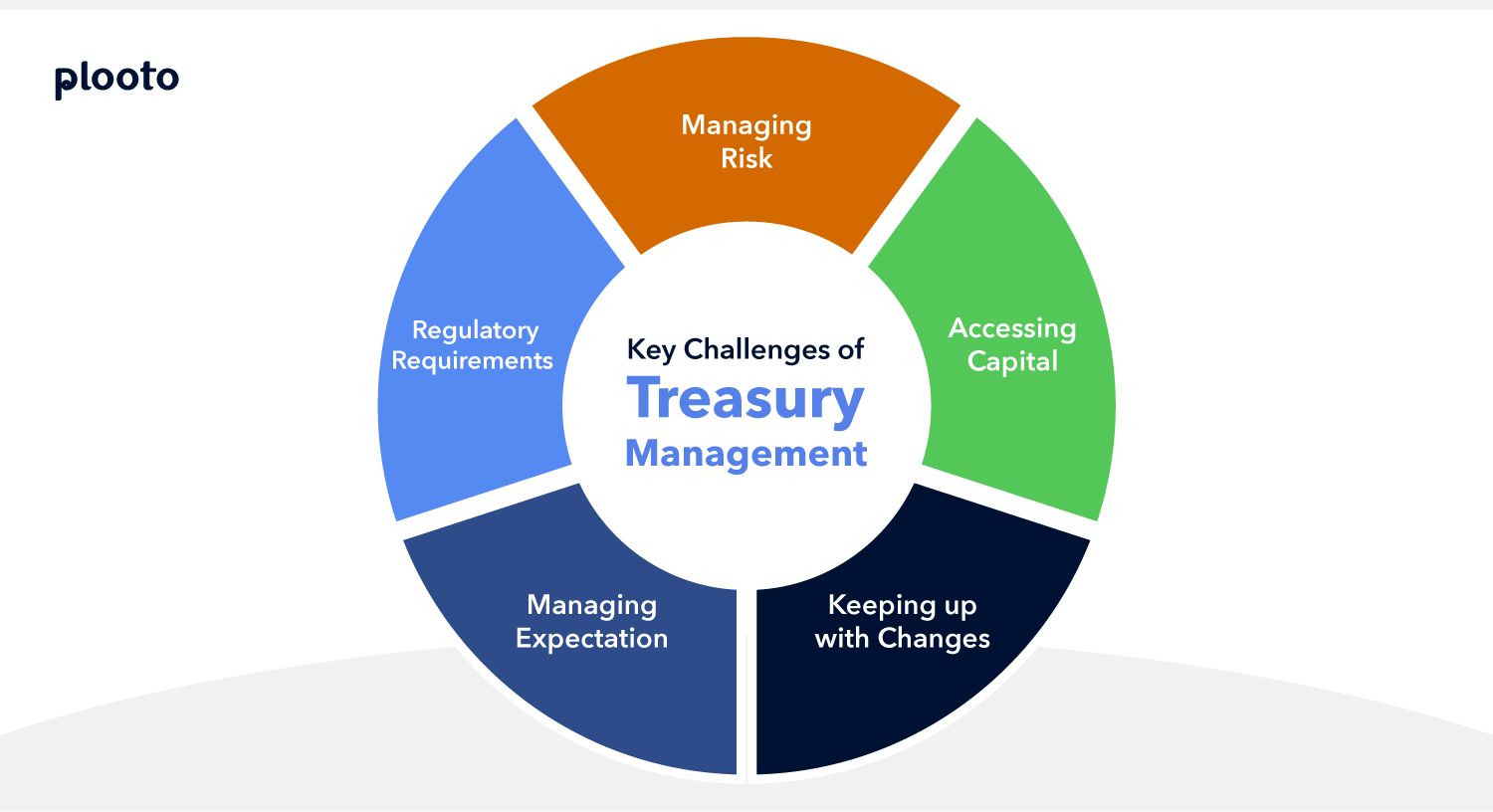
Treasury management is vital to promoting growth and financial health in your business. It ensures sufficient cash flow for business needs, and tracks debts and investments, all while minimizing risk.
Working capital is the difference between your business's current assets and current liabilities - giving you insight into your liquidity. This insight ensures you have enough cash to sustain daily business operations while planning for future investments.
“How Working Capital Impacts Treasury”, details how treasury management works and how you can best implement it into your business.
The main objective of treasury management
The overarching goal of treasury management is to optimize company finances while mitigating risk. Treasury management involves determining the appropriate amount of cash needed to fulfill short-term and long-term financial obligations. Treasury management teams focus on three key areas: liquidity, risk, and capital efficiency.
Managing liquidity ensures businesses have sufficient cash to navigate cash issues or uncertain circumstances. Mitigating risk includes continuously analyzing macroeconomic trends and their potential impact on the business, so proactive procedures can be implemented. Lastly, capital efficiency optimizes company resources and allows for informed decisions about reinvesting back in the business for sustainable growth.
Overall, treasury management plays a vital role in shaping the financial direction and planning of the company, while ensuring finances are aligned with the strategic goals of the company.
How Does Treasury Management Work?
Treasury management works by consistently monitoring internal and external factors that impact a company's cash flow. Analyzing these factors allows treasury management teams to organize suitable cash levels. Additionally, treasury management aligns with the goals of the company and creates visibility of cash flow. Functions of treasury management include:
Minimizing risk
Effective treasury management equips the business with strategies to mitigate changes in economic and business uncertainties. This involves gaining a clear picture of cash flow and the possible impact of risks. Part of risk mitigation is developing procedures and policies for detecting fraud and discrepancies to minimize potential threats to the business.
For businesses involved in international currencies, treasury management mitigates the risk of the foreign exchange market (Forex). Cash losses must be minimized when trading between different currencies.
Forecasting
Treasury teams can use forecasting to anticipate future cash needs of the business, as well as estimate future financial positions. Identifying future cash surpluses and deficits ensures informed decision making for future events. Additionally, forecasting allows the treasury team to plan for future goals.
According to Mike Ford, a Forbes Council Member, to prepare for unseen circumstances, it's best to examine your potential revenue and prioritize your expenses. Forecasting helps you prepare procedures to navigate uncertain situations.
Working Capital Management
Working capital management ensures financial resources are being used effectively. It is responsible for meeting short-term financial obligations while planning for long-term objectives. Working capital management also ensures appropriate resources are available in preparation for uncertain situations.
A key component of working capital management is monitoring assets and liabilities to satisfy business needs. Within treasury management, it is vital to balance the amount of working capital you have - an excess of working capital restricts investment potential, while insufficient working capital jeopardizes meeting financial commitments.
Portfolio management
When excess business funds can be invested to generate a return, treasury management includes monitoring the company portfolio and associated risks.
The Treasury Cycle
The treasury cycle encompasses all the processes related to the timing of financial obligations and receivables. Tracking these processes is a constant practice in treasury management. The cycle includes:
Cash flow management and optimization
Managing and optimizing cash flow is crucial for ensuring the continuation of the business and making informed financial decisions.
Cash flow management includes: monitoring daily cash flow, tracking future payables and receivables, preparing for payments, and maintaining adequate cash levels. Cash flow management can be optimized through scheduling to ensure there is enough available cash when needed.
Financing decisions
For your business to succeed, you must decide how and when to obtain financing. Financing options may include: issuing bonds, stocks, and incurring short-term or long-term debt.
These financial decisions are made within the context of treasury management, as forecasting and understanding cash flow allow businesses to determine when financing might be needed or beneficial for growth.
Tracking maturity
Tracking the maturity of investments and borrowings is key to collecting or paying obligations on time. Monitoring these timelines is crucial for maintaining cash flow, and fostering relationships with stakeholders and suppliers.
The Treasury Process
The treasury process outlines the procedures, actions, and controls used to execute the treasury cycle while minimizing risk. Some of these processes include:
Transaction Processing
To ensure accurate maintenance and monitoring of cash flow, transactions must be processed. This is accomplished by: analyzing receipts, collections, and invoices to ensure cash flow numbers are correct.
Understanding the transaction schedule provides insight into the timing of cash inflows and outflows, enabling better preparation of sufficient funds. Lastly, with analysis, you can ensure transactions are being sent and received efficiently and securely.
Reporting
An integral part of treasury management is preparing financial reports. Reports have many purposes, including providing data and recommendations for financial decisions, and evaluating current methods being used. Procedures should be implemented to dictate the timing, content, and use of financial reports.
Forecasting Procedures and Tools
Forecasting plays a vital role in optimizing cash flow and minimizing risk. It complies with information from tracking expenses and receivables, schedules of loan maturities, business trends, and macroeconomic changes to provide recommendations for financial planning. Implementing forecasting tools and analysis enhances risk management and cash flow optimization.
Risk Management
Risk management is necessary when dealing with business finances. This involves creating procedures for fraud prevention and using forecasting to prepare for changing business environments and uncertain situations.
According to the Association of Certified Fraud Examiners (ACFE) global study, in 2020, the median loss due to a fraud case was $125,000. The ACFE also found the existence of anti-fraud controls is associated with lower fraud losses and quicker detection. It's ideal to have these types of procedures in place to minimize your organization's risk of fraud.
Risk management is a crucial part of treasury management. Clear controls should be in place across all financial practices to minimize associated risks.
Types of Treasury Management
There are a few options available for treasury management solutions:
Corporate finance services
Corporate finance services assist your business in managing treasury. These services offer experience in consulting, reporting, funding, and risk management. Additionally, they can develop strategic long-term and short-term plans while giving insights into market conditions and analysis. These services optimize your resources while aligning your finances with your business goals.
Bank services
Certain banks offer treasury management solutions; they can aid in optimizing your account usage. Bank services have capabilities for forecasting, account automation, and data integration. Bank services can provide the tools and resources to enhance your treasury management processes.
Treasury Management Software (TMS) vendors
TMS solutions empower you to manage your treasury in-house. Software solutions can offer cash management visibility, forecasting, data visualizations, and payment controls. With numerous options for TMS systems, you must choose software with features that best fit your business needs.
With a solid understanding of your treasury management needs, you can find the best approach to suit your business goals.
Cash Management vs. Treasury Management
Although cash management and treasury management have similar objectives and may appear like interchangeable terms, there are key differences in their approaches. Treasury management is a boarder term that encompasses many cash-related processes - including cash management.
Treasury management
- Manages all aspects of a company's finances.
- Focuses on short-term and long-term goals to maximize profits and maintain financial stability.
Cash management
- Focuses on short-term cash goals such as: maintaining sufficient cash for business needs.
- Involves monitoring cash flow, forecasting expenses and income, and optimizing cash resources.
- A function of treasury management concerned with monitoring and managing cash.

What makes Treasury Management so Important?
Treasury management is important for the financial health of your business. Not only does effective treasury management optimize your capital resources and maintain cash flow, but it also allows you to make more informed decisions about the future needs of your business.
Treasury management is vital for funding opportunities and planning the optimal time for incurring debts. Additionally, treasury management gives you insight into the future position of finances and prepares for arising uncertainties. This is accomplished through risk mitigation and forecasting - two key functions of treasury management.
Overall, treasury management keeps the business afloat by forecasting future risks, maintaining sufficient cash when needed, and allocating resources effectively.
Core functions of a treasury management department
Minimizing financial risk
- Managing the risk in foreign exchange markets.
- Creating a cushion for uncertainties.
- Developing procedures and policies to thwart threats.
Liquidity management
- Ensuring sufficient funds available to the business.
Working capital management
- Balancing working capital and investments/liabilities.
- Investing back into the business when appropriate.
Cash flow forecasting
- Prepare and allocate funds according to future needs.
Payments
- Streamlining the payment process and analyzing costs.
- Ensuring payments are accurate, efficient, and secure.
Funding
- Issuing bonds and shares to raise capital.
- Taking on funding opportunities at optimal times.
Decision making
- Providing the data to facilitate informed decisions.
- Using data to accurately forecast and analyze financial performance.
- Making decisions surrounding optimizing capital.
Treasury Management Best Practices
How can you successfully manage your treasury? Follow this framework to effectively navigate treasury management in-house:
Leverage software solutions
TMS software can maximize the effectiveness of treasury management. By utilizing forecasting tools and variance analysis, you can predict risks and future cash flow. Software solutions automate tedious processes and reduce the time spent on manual tasks.
Prepare for risks proactively
Using forecasting, you can accurately assess risks and make appropriate preparations. It is always better to be prepared rather than rush to respond to a situation once it occurs. Utilize hypothetical scenarios to create procedures to cope with different risks.
Increase cash visibility
Keep records and invoices organized to promote better visibility of cash flow. Creating a high-level view of cash inflows and outflows will help you allocate resources effectively.
Centralize treasury management
Centralizing a treasury management team ensures one sole focus and established leadership. With a treasury-focused team, you can hire experts in the field and enable better decision-making.
Incentivize correctly
To improve efficiency, it is important to incentivize your treasury management team properly. Incentives can be used to discourage risky investments and procedures while rewarding exceptional performance. Incentivize specific and measurable goals that align with the bigger picture. Lastly, reward employees soon after the value has been delivered.
Monitor continuously
Keeping updated on all areas of the financial picture is key to successfully managing treasury. Consistently monitor cash flow, changing regulations, and maturities of receivables/payables. This ongoing process enables you to adapt your strategies and respond to any changes.

Challenges of Treasury Management
Key challenges of treasury management are often brought about by today's uncertain economic changes and evolution in technology. Some key challenges of treasury management to be mindful of are:
- Managing cash flow in an uncertain economic climate.
- Continuously evolving payment fraud techniques.
- Changing regulatory requirements.
- Obtaining capital for business needs.
- Changing interest rates.
- Maintaining management standards with an expanding, multi-location company.
- Mitigating ever-changing risks.
- Keeping up with improvements in software and external technologies.
How Working Capital Impacts Treasury & Finance
Working capital is the difference between your business's current assets and current liabilities. This demonstrates the liquidity and ability of your business to meet short-term financial obligations.
Working capital impacts the treasury department's ability to plan and fulfill these commitments. Low working capital impacts the ability of the treasury department to pay for financial responsibilities. On the other hand, an excess of working capital creates an opportunity for the treasury team to re-invest back into the business.
Cash flow forecasting, another key aspect of treasury management, is directly impacted by working capital. Working capital fluctuates with cash, requiring treasury managers to be aware of the impact on cash flow. Accurate forecasting of surpluses of cash or deficits influences decisions about repayment, investing, or resource allocation.
Evaluating working capital enables the treasury department to identify potential risks to the company's financial health. Treasury management must forecast and plan to avoid working capital shortages. A shortage in working capital hinders the ability of the business to meet daily financial needs and creates instability.
The strategies and planning developed by treasury management teams are heavily influenced by working capital. Close monitoring of working capital enables the treasury team to minimize risk to the business, forecast cash flow and manage liquidity.
How digital automation can help treasury manage working capital
Treasury management aims to optimize company finances and ensure short-term and long-term business needs are fulfilled, all while mitigating risk. This requires cash visibility and controls over cash in-flows and out-flows. Using software solutions can give you the data and insights to optimize your treasury management. Plooto gives you enhanced visibility into your cash flow by tracking and displaying your payables and receivables.
Enhance your control over payments with Plooto's approval process. Plooto gives you the capability to add rules and controls over sending payments - allowing you to ensure the accuracy of bill payments and the correct approvals.
With Plooto, your payment reconciliation is automated. When you make a payment, it is tracked in your accounting software and recorded in your books - all automated to decrease the risk of human errors reaching your accounting journals.
With the ability to add controls to the payment process and decrease the chance of human error in balancing your receivables and payables, Plooto minimizes the risk of lost finances and time due to errors.
Frequently asked questions
What is treasury management?
Treasury management is all the processes and procedures that maximize a company's finances while mitigating risk. It manages meeting short-term and long-term financial commitments while planning for broader company objectives and optimizing its resources.
Why is treasury management important?
Treasury management is vital to a company's financial health; it keeps the business afloat by preparing for cash inflows and outflows and forecasting future risks to the business. Not only does effective treasury management optimize your capital resources and maintain cash flow, but it also allows you to make more informed decisions about the future needs of your business.
What is a Treasury Management System (TMS)?
A treasury management system (TMS) is a software solution that streamlines processes of the treasury management process. Often, softwares have features to automate manual processes, forecast cash flow, and increase cash visibility.












